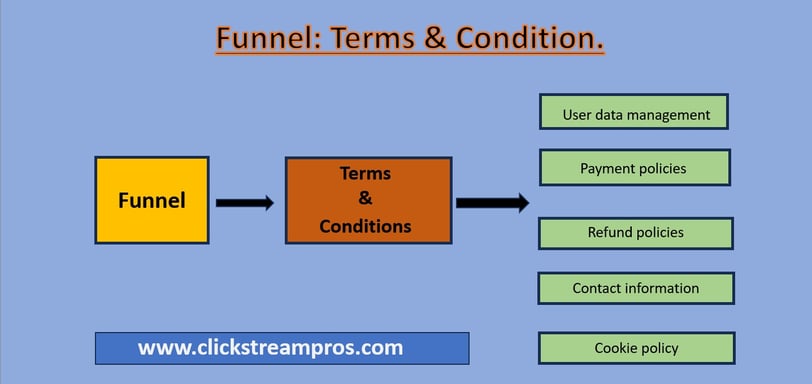Funnel : Terms and condition
Terms and condition while creating your funnel on every step.
DIGITAL MARKETING
nikunj irani
5/28/20242 min read


Hi digital marketers! Today we are going to talk about the terms and conditions of a funnel.
What Are Terms and Conditions?
Terms and conditions are pages created by the owner of the funnel at different levels of the funnel. They can be used in two different ways:
1. General Terms and Conditions
These terms and conditions are applied to your website where the user can see generally what terms and conditions the website follows. These are mostly generic and are followed in the same format on most websites.
2. Accepting Terms and Conditions
These terms and conditions are applied when the user has to accept them. They can cover several aspects of the funnel including:
User data management
Payment terms and conditions
Refund policies
Contact information
Cookie policy
Other specific requirements if needed
How to Write the Right Terms and Conditions for Your Funnel
This depends on what kind of website or funnel you are creating.
If we are creating a blogging website/funnel, then we can use generic terms and conditions.
If we are creating a complex funnel structure, then we could resume all types of terms and conditions mentioned above for your funnel to work smoothly at all stages.
Where to Apply Terms and Conditions
In this section, we will discuss where to apply which terms and conditions for the smooth legal functioning of the funnel.
1. Awareness Stage
In this stage, you will be creating awareness through blogs and other content types. You will need a generic terms and conditions page that is in line with Google and Meta policies in the backend.
2. Ad and Retargeting
To run ads on different ad accounts like Meta and Facebook ads, you will require a terms and conditions page that discloses:
What you are going to do with the data of the users
How you are going to protect the data
Whether you are collecting data for third parties
If your ad and terms and conditions don’t match, your ad accounts or even your campaign could be affected.
3. Call to Action Page
This is generally your landing page. You will need terms and conditions on this page that discuss:
Your product or service
Delivery timelines for your product or service
Product return policies and other related aspects
4. Closing Sales
This step of your funnel is very specific. Most users read these terms and conditions, and because of that, there are a lot of misunderstandings and potential brand damage. This section should include:
Payment policies
Refund policies
Contact information
Types of payment options
Updating Your Terms and Conditions
When you check your mail, you usually see emails like "updated policies" or "updated terms and conditions" from the websites and apps you have subscribed to. This is because, in their funnel, they have left a scope for updating the terms and conditions. They update them due to many reasons such as changes in government rules or updates in the third-party backend.
In all your terms and conditions pages, you should leave space to update your terms and conditions for the user.
Updating Your Users About Terms and Conditions Updates
It is very important to update your users about terms and conditions updates. They will need to accept the new terms and conditions. This can be done in the following ways:
Send emails about updated terms and conditions.
Notifications are also a good option for telling your users about the updates.
PR on other websites: You can update the users by writing a blog on a third-party website. This also acts as a public notice and you can get a backlink.
Best Ways to Generate Terms and Conditions
We hope this article was useful to you.
